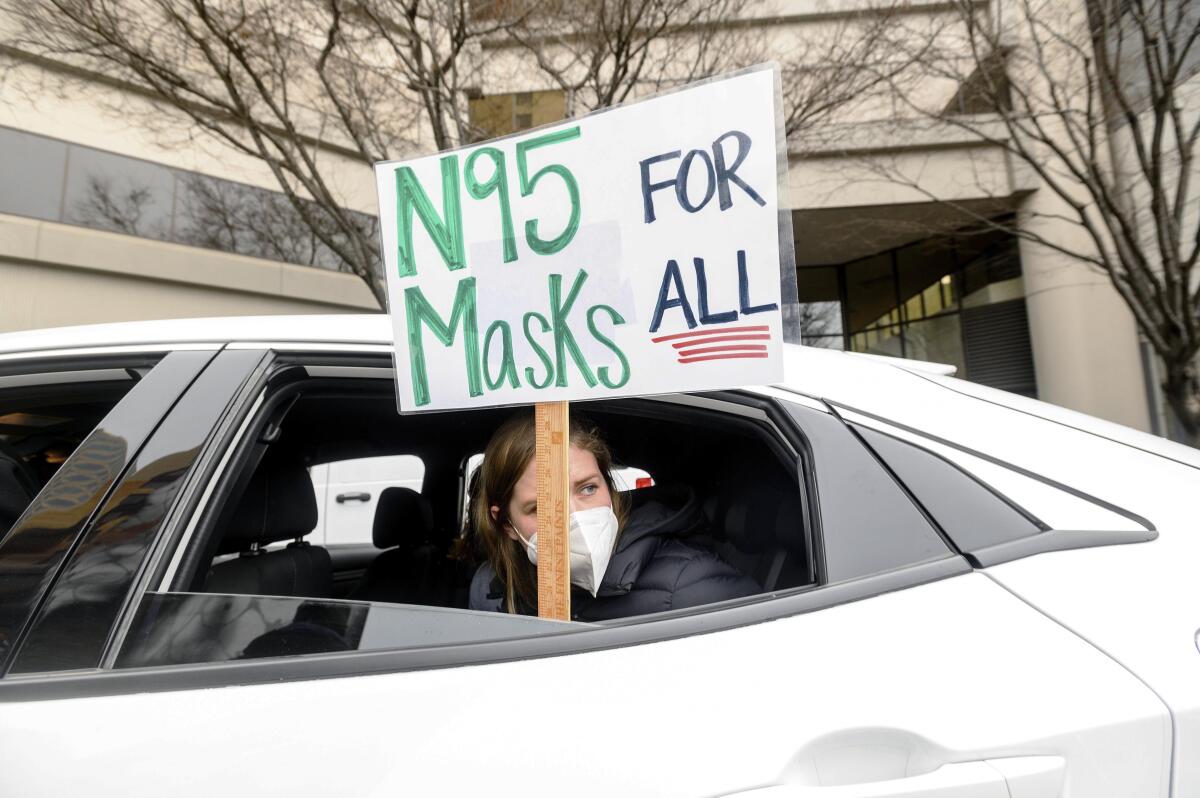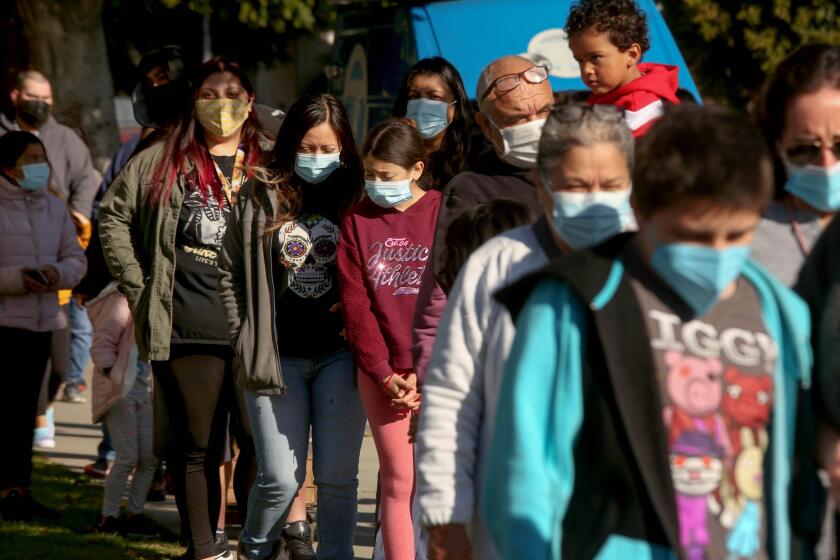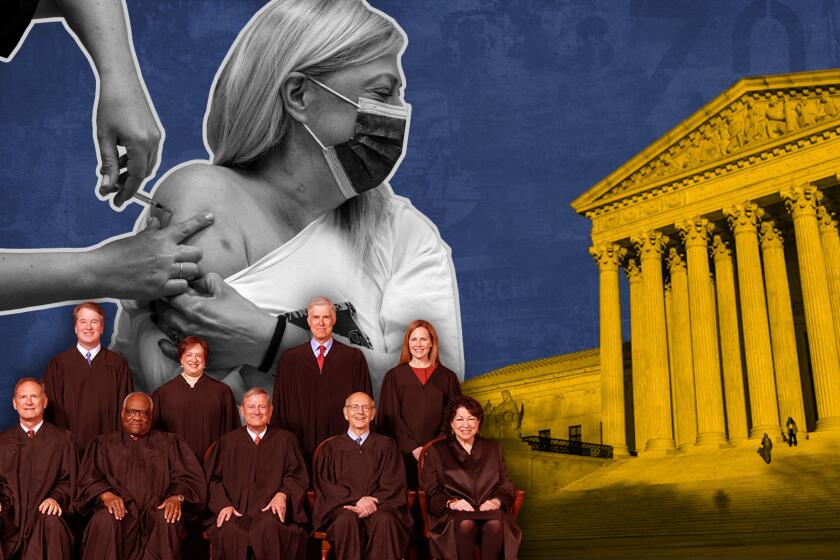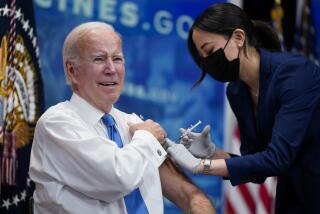‘They underestimated this virus.’ Omicron cuts through U.S. defenses despite Biden’s efforts

After the Omicron variant began spreading through the United States just before the holidays, President Biden unleashed what he described as a sweeping effort to bolster the country’s defenses.
He pledged reinforcements for overwhelmed hospitals, more home tests to screen for infections and new investments in vaccine access.
But little seems to be slowing Omicron’s spread, despite Biden’s insistence that he’s “confident we are on the right track” as the pandemic enters its third year. Although vaccines are preventing what could have otherwise been a devastating death toll, hospitals are being pushed to their limits. Meanwhile, Americans are frustrated with confusing public health guidance, the struggle to find tests and renewed uncertainty over whether schools will keep their classrooms open.
Biden plans to update the country on his administration’s efforts on Thursday, a speech that comes as his administration faces escalating criticism from health experts and even some former advisors.
“The big tragedy here is that we came through last winter and even the summer, and never did the work to address the structural issues that are putting us back in the situation that we’re in right now,” said Dr. Megan Ranney, academic dean at the Brown University School of Public Health. “Nothing that is happening today is unpredictable.”
Some of today’s challenges are rooted in decisions made months ago, said Dr. Rick Bright, a public health expert at the Rockefeller Foundation and a former member of Biden’s transition team. He said administration officials failed to prepare for more contagious variants when Biden declared on the Fourth of July that the country was “closer than ever to declaring our independence from a deadly virus.”
“They underestimated this virus,” Bright said.
Now, he said, “the administration is overwhelmed with this current surge.”
In general, tests are able to reveal an Omicron infection, but enough virus needs to have reproduced and appear at sufficiently high levels in the nose or saliva to be detectable, health officials say.
White House Press Secretary Jen Psaki has defended the response to Omicron, noting this week that “we are in a different place than we were a year ago” because of widespread vaccine distribution. She also said the administration has spent months pushing to increase the manufacturing of test kits.
However, some new testing initiatives are only coming online now. On Saturday, Americans with private health insurance can start getting reimbursed for the cost of eight home coronavirus tests per month. The administration has also secured 50 million tests that can be ordered for free through a government website by the end of January. Another 450 million tests are expected to be available in subsequent weeks.
On Wednesday, the White House announced that millions more tests would be provided to schools to help screen students and staff for infections, part of a new “test to stay” strategy that’s intended to keep classrooms open.
The Omicron variant is the latest and most contagious strain of the coronavirus to emerge since the pandemic began. Not only is it more transmissible than the Delta variant, which tore through the country last year, it’s also more likely to cause breakthrough infections among vaccinated people.
The result is a disorientating and unsettling moment even though vaccines continue to offer protection from serious illness and death, especially when a booster shot is added.

“It’s hard to process what’s actually happening right now, which is most people are going to get COVID,” Dr. Janet Woodcock, the acting commissioner of the Food and Drug Administration, said during a Senate hearing on Tuesday.
Senators from both sides of the aisle bristled with irritation at the hearing, which featured the administration’s top health officials.
Sen. Patty Murray (D-Wa.) complained about convoluted rules on when people should isolate after infections and said the administration’s efforts have fallen short.
“I’m frustrated that we’re still behind on issues that are as important to families as testing and supporting schools,” she said. “That’s not to say we have not made progress, it’s just clear we haven’t made enough.”
Sen. Richard Burr (R-N.C.) said the administration has lost the trust of the American people, adding that “I’m at the end of my rope.”
Dr. Anthony Fauci, Biden’s top medical advisor, told senators that “we’re doing the best we possibly can” against what he described as “a very wily virus.”
Supreme Court conservatives express skepticism of President Biden’s mandate that most workers be vaccinated for COVID-19.
As Biden confronts the Omicron variant, he’s faced consistent political hurdles.
Some Americans, particularly conservatives, are unwilling to get vaccinated.
Twenty-seven Republican-led states are arguing that Biden overstepped his authority with a plan to require most American workers to become vaccinated or get regularly tested. The issue is now in limbo as it awaits a decision from the U.S. Supreme Court, where conservatives hold a majority.
Republican governors have also balked at further COVID-19 mandates, such as requiring masking indoors.
But some of Biden’s allies have also urged the administration to make a course correction.
Former members of Biden’s transition team have written in medical journals that policymakers need to prepare for a “new normal,” shifting from a state of emergency to improving the public health infrastructure to help the country cope with the coronavirus as a permanent threat.
Dr. Celine Gounder, an infectious disease expert at New York University who co-authored one of the articles, said the administration has focused on vaccinations while neglecting other strategies.
“Vaccines are the No. 1, No. 2, No. 3 most important tools in the tool box,” she said. “But they’re not the only tool.”
The administration should have begun broadening its approach back in the spring, when the extent of vaccine hesitancy became apparent, she said. The original thought was “if we build it, they will come,” but large swaths of the country remain unwilling to get their shots. More than 25% of adults in the U.S. are not fully vaccinated.

For example, she said, the administration should be working harder on getting Americans to upgrade their masks because cloth versions provide less protection against Omicron. The Centers for Disease Control and Prevention website still recommends well-fitting cloth masks as a prevention method. But more people should be wearing N95 or KN95s, Gounder said.
“I don’t think that has sunk in. People also assume those masks will be uncomfortable,” she said. “Sometimes you just need to put it in front of someone.”
It’s unclear exactly how damaging the Omicron wave will end up being. There are indications that the variant is causing less severe illness, and the nationwide tally of coronavirus hospitalizations includes a significant number of patients who test positive even though they were admitted for other reasons.
However, Gounder said, the variant could ultimately prove more harmful in the U.S. than in South Africa, where its existence was first reported, or the United Kingdom, which has suffered its own wave.
For example, South Africa has fewer senior citizens, who are more vulnerable to COVID-19, and the variant struck when the country was experiencing its summer, so people were less likely to be hunkered down indoors during cold weather. And the U.K. has a more extensive public healthcare system with paid leave benefits that can help people cope with the pandemic.
COVID case numbers are still going up. Kids under 5 won’t be eligible for vaccination for months. How can parents make smart decisions in the meantime?
But in the U.S., the Omicron wave may only get worse. After spreading first in places like New York, it will eventually reach less vaccinated areas of the country.
“The numbers don’t look good,” Gounder said.
Dr. Robert Wachter, chair of UC San Francisco’s Department of Medicine, said caseloads have exploded even faster than anticipated, but he’s hopeful that the Omicron wave will crest soon.
“In other places that are ahead of the curve, they are finding what we would have hoped, that this is just going to be just awful and enormous and hit a rapid peak and come down just as quickly,” he said.
For now, rising hospitalizations are straining medical staff. Many healthcare workers across the nation left the field due to burnout, low wages or a combination of both in the last year.
Ranney, the Brown University dean, said Biden’s plan to deploy 1,000 military medics is “better than nothing, but it’s not adequate,” adding that the administration must focus on recruiting and retaining medical staff to effectively combat this surge and any future ones too. Such an initiative could include hazard pay bonuses or loan repayment incentives to support “the bedrock of the system,” including nurses and medical assistants, Ranney said.
Dr. Jay Varma, professor of population health sciences at Weill Cornell Medicine, said he had been “very optimistic” at the start of the Biden administration because its approach to the pandemic “was a complete reversal of what had happened during the previous administration.”
“Unfortunately, it appears that a lot of that plan was not executed as vigorously as it appeared to have been planned at the beginning,” he said. “And so what we’re seeing right now is an attempt to catch up on that.”
Varma pointed to a national need for “cheap, abundant, high-quality home tests,” adding that it is “simply unacceptable for us not to have that type of testing available to everybody everywhere, regardless of your ability to pay.”
Like Ranney, Varma pointed to a need for long-term solutions from the Biden administration.
“My real concern is not that what they promised right now is not enough,” he said. “I want to be reassured that what they’re doing now is simply a down payment on a much more vigorous investment in the plan that they originally laid out when they came into office.”
Get our L.A. Times Politics newsletter
The latest news, analysis and insights from our politics team.
You may occasionally receive promotional content from the Los Angeles Times.
More to Read
Get the L.A. Times Politics newsletter
Deeply reported insights into legislation, politics and policy from Sacramento, Washington and beyond. In your inbox three times per week.
You may occasionally receive promotional content from the Los Angeles Times.











